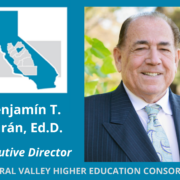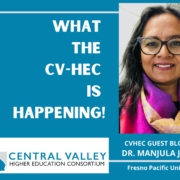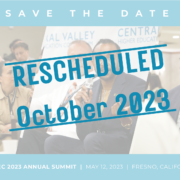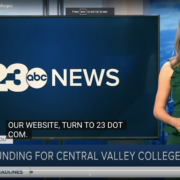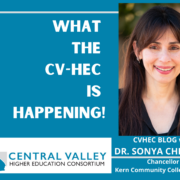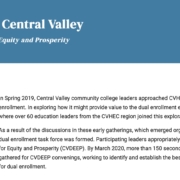CVHEC DIRECTOR’S MESSAGE (May 2023): Extraordinary times!
Winding down an extraordinary
academic year in the Central Valley
Greetings colleagues,
As we welcome you to the May issue of our newsletter, we take this opportunity to thank, congratulate and salute all the CVHEC educators who have dedicated themselves to sending off another group of Central Valley students into the next phase of their academic and or professional lives. This annual commencement season is truly a magical time of the year and reminds us all why we chose careers in higher education.
In this issue we present more about Math Bridge, the math pathways initiative launched May 18 by bringing together representatives of six regional community colleges and their partner feeder high schools. At this kickoff held in downtown Fresno, these dedicated and determined professionals began the process to jointly create college level dual enrollment math courses targeted at underrepresented student populations that will allow them to complete a college math course before graduating from high school. This innovative project is unique because of the intersegmental collaboration between high school and community college math faculty members working together to ensure their students’ success.
You will also have an opportunity to visit the CVHEC board meeting held May 11 in Fresno. Board members heard a joint presentation by Dr. James Zimmerman, senior associate vice provost and dean of Undergraduate Education at UC Merced, and Dr. Lynn Cevallos, president and founder of College Bridge. They addressed the evolution and overlap of two CVHEC endeavors, the Central Valley Transfer Project and the Math Bridge initiative, that helps clear pathways for students getting into and through community college and onto the university of their choice.
We also bid farewell to two dear colleagues although one will remain well in sight, Dr. Sonya Christian who served on our board as chancellor of the Kern Community College District but now moves up to chancellor of the California Community College system. And joining us one last time at the meeting was the esteemed Dr. Ellen Junn, Stanislaus State president whose retirement is effective next month. We know you join the board in thanking them for their service to higher education in general and the consortium in particular. And you may read about our newest board additions in the story and photo gallery about the board meeting.
Please enjoy this issue as well as the conclusion of this extraordinary semester.
PRESS RELEASE: Central Valley Math Bridge kickoff May 18 in Fresno
ADVISORY: For media coverage of the Central Valley Math Bridge Kickoff on Thursday, May 18 (9 a.m. to 3 p.m.), or for spokesperson availability, please text Tom Uribes at 559.348.3278. LOCATION: The Doubletree by Hilton Hotel/Fresno Convention Center (2233 Ventura St. – Fresno). See Agenda.
(UPDATE May 26, 2023) – See Math Bridge coverage.
Central Valley Math Bridge: keeping the doors to STEM careers open for our students
13 rural high schools, six community colleges to convene for program kickoff May 18 in Fresno
(May 16, 2023) — The first cohort of 13 Valley high schools has been secured for the Central Valley Math Bridge Program that will promote equity and college-readiness in mathematics via dual enrollment courses for underprepared students at rural high schools in the region next fall (see list of high schools below).
The participating educators will convene this week with six community college members of the Central Valley Higher Education Consortium in Fresno to formally launch the program and plan for its implementation at the Central Valley Math Bridge Kickoff from 9 a.m. to 3 p.m. Thursday, May 18, at Doubletree by Hilton Hotel Fresno Convention Center.
The launch is presented by co-hosts College Bridge, Central Valley Higher Education Consortium and the Rand Corporation.
Dr. Lynn Cevallos, founder and president of College Bridge, will deliver keynote remarks, “The State of Mathematics in California,” an analysis of intersegmental mathematics policies and practices statewide over the last 20 years that highlights a pending crisis now facing Valley students.
“The doors to STEM careers are closing for our students,” Cevallos warned. “The Math Bridge project is designed to keep those pathways open.”
In one morning session, “Collaborating Towards a Common Goal: Dinuba Success Story,” officials from Dinuba High School will share their experience with a previous College Bridge program — the Math Pipeline Readiness Project (M-PReP) — that provided the foundation for the current project.
Presenting will be DHS Principal Andrew Popp, Counselor Auggie Sanchez and Jim Gilmore, Math professor at Reedley College which was the DHS community college partner.
Dr. Benjamín Durán, CVHEC executive director, will deliver closing remarks along with Cevallos.
“The DE Math Bridge Project will prepare and guide students as they transition to college or university equipped with math credits and confidence,” said Durán, president-emeritus of Merced College who became CVHEC’s executive director in 2016. “It creates a model for meaningful dual enrollment pathways and expansion that can be replicated in other regions of California serving underprepared students. This also supports CVHEC’s mission to increase degree attainment rates.”
The Central Valley Math Bridge project was initially funded by a $4 million five-year Education Innovation and Research (EIR) Program federal grant awarded by the U.S. Department of Education to College Bridge in late December.
College Bridge recently completed an extensive four-month recruitment campaign to secure eligible high schools for the first of two cohorts. Recruitment of the second cohort will begin this summer, Cevallos said.
The first cohort of high schools to-date and their respective community college partners are (with three additional pending*):
Cerro Coso College: Lone Pine, Tehachapi;
Columbia College: Bret Harte*, Calaveras*;
Madera College: Liberty, Madera, Madera South, Matilda Torres, Yosemite;
Reedley College: Dinuba, Orosi, Parlier, Reedley*
Taft College: Taft High School
West Hills Coalinga College: Firebaugh, Tranquillity.
High schools and community colleges interested in participating in the second cohort may contact Nicole Korgie at nicole.korgie@college-bridge.org.
For more information about the May 18 event, contact Angel Ramirez, CVHEC operations manager at 559.292.0576 (centralvalleyhec@gmail.com). Media inquiries: Tom Uribes at 559.348.3278.
NOTE: A parallel project funded by the state in February through the Central San Joaquin K-16 Partnership — made up of the Fresno/Madera and the Tulare/Kings K-16 Collaboratives — will serve an additional two colleges and seven high schools in the region (see https://bit.ly/CVHEC-DualEnrollmentMathBridge).
See background stories
https://bit.ly/CB-DualEnrollmentMathBridgeAnnounced
https://bit.ly/MathBridgeDualEnrollmentKickoff
UPDATES
- What the CV-HEC Is Happening Blog: Math Bridge Update
- “What the CV-HEC is Happening” Blog – The Gift of Math
ABOUT CVHEC and COLLEGE BRIDGE
The Central Valley Higher Education Consortium based in Fresno, made up of 28 institutions of higher education in the Central Valley’s nine-county region, is assisting the Dual Enrollment Math Bridge Project by using its role as a regional convener to bring the participating higher education and K-16 representatives together with College Bridge, a California non- profit based in Los Angeles County dedicated to creating a seamless K-16 pathway for students.
AGENDA-MathBridgeKO(051823)media
WHAT THE CV-HEC IS HAPPENING GUEST BLOG (April 2023): Kern Math Master’s Upskilling/Dr. Manjula Joseph
 With the first cohorts of the Kern Master’s Upskilling Program underway, this guest blog is by Dr. Manjula Joseph, associate professor and program director for math education at Fresno Pacific University, a CVHEC member institution. She reflects on the experiences of the math cohort offered by FPU with 21 current practicing high school teachers enrolled in the program designed to empower them to create classrooms that foster a love for math with specific sights set on eventually teaching dual enrollment courses at their respective high schools. This first Kern math cohort completes in July 2024. (An English master’s cohort offered by CVHEC member National University is also currently in session).
With the first cohorts of the Kern Master’s Upskilling Program underway, this guest blog is by Dr. Manjula Joseph, associate professor and program director for math education at Fresno Pacific University, a CVHEC member institution. She reflects on the experiences of the math cohort offered by FPU with 21 current practicing high school teachers enrolled in the program designed to empower them to create classrooms that foster a love for math with specific sights set on eventually teaching dual enrollment courses at their respective high schools. This first Kern math cohort completes in July 2024. (An English master’s cohort offered by CVHEC member National University is also currently in session).
Transforming Practicing Teachers into Innovative Math Educators
Embracing the shift in math education for the Kern Master’s Upskilling Program: Fresno Pacific University’s MA in Mathematics Education
By Dr. Manjula Joseph
Program Director, Math Education – Fresno Pacific University
I enter the (zoom) room and observe a class in session.
The students in the first cohort of our Kern Master’s Upskilling Program for practicing high school math teachers are sharing celebrations and challenges about life events – school, family, health, etc. Some of them request prayer.
After this brief time of sharing, they are presented with a graph of an intertwined circle and parabola with a red-shaded area and asked to respond to the prompts “What do you notice? What do you wonder?” on a Google Jamboard. Their two-dozen responses range from noticing symmetry to wondering what the center of the circle might be. Then, moving to breakout rooms to discuss how they might solve the problem at hand, they write their thoughts on the Jamboard.
The complex problem involves differential and integral calculus, trigonometry and intricate algebraic manipulation. Not initially finding answers only seems to push them further to learn unfamiliar concepts, expand prior knowledge and reach a solution.
Professor Alice Keeler, the instructor, and I silently observe this activity unfold and marvel. What I have just observed firsthand is a genuine “community of learners” engaged in supporting and strengthening each other’s content and pedagogical knowledge.
Student Kim Halbrook also observes: “The program is designed to build ‘a community of educators’ willing to support and help each other be the best teachers they can be.”
So, what makes FPU’s program unique?
In a rapidly evolving educational landscape, our Master of Mathematics Education program at Fresno Pacific University (FPU) stands out as a beacon for change.
Focused on a humanized, student-centered approach, we transform practicing teachers into innovative math educators who embrace the shift from traditional instruction towards a more engaging and holistic learning experience without compromising rigor.
Propelling the Shift in Humanizing Mathematics
We see mathematics as a deeply humanizing activity emphasizing critical thinking, problem-solving and collaboration — a fundamental shift from viewing it as cold and abstract, and emphasizing speed and competition.
Mathematics affords us the space to explore the mysteries of the universe and appreciate the beauty and order that underlies it. Mathematics also allows us to think logically and critically about the challenges and inequities that plague society, empowering us to contribute to the advancement of human knowledge, social justice and progress.
Our program helps teachers embrace this shift, enabling them to foster a love for mathematics, a joy for exploration and a passion for problem-solving in their own classrooms.
“Fresno Pacific University has provided more content-specific advancements in my career as an educator than the entirety of my Teacher Preparation Program,” says student Brandon Butler.
Believing Engagement is More Than Just Fun
Our program recognizes that engagement is not synonymous with fun. We believe that true engagement comes from feeling rewarded for one’s efforts and that students would rather work on challenging tasks (absorption) than boring, easy tasks (compliance).
We prioritize student engagement through personal connections, using collaborative tools and interactive activities. Our approach models compassion and grace, encouraging teachers to create classroom environments where mathematics is seen as a means for thinking and engaging, rather than as a competition.
Student Edna Cruz affirms: “I have learned so much about integrating technology in a way that encourages students to think and engage in productive struggle. All this in a course that unites a group of people who genuinely love math and the advancement of education, to better serve the students of our community. We are all taking what we are learning and implementing it in our own classrooms.”
Balancing Commitment with Life
Our program acknowledges the challenges faced by teachers who must balance their commitment to earning a master’s degree with their existing teaching responsibilities and family life.
With this in mind, we designed a student-centered program that cares for students not just as learners but as individuals with unique personal and professional lives. This philosophy influences assignments, discussions, and interactions. We view students (both ours and their students in turn) as whole persons, cultivating an environment where teachers can develop their skills while maintaining a strong connection to their own values and personal lives.
A Passion for Reimagining Math Education
In conclusion, the Master of Mathematics Education program at Fresno Pacific University offers a transformative experience for practicing teachers passionate about reimagining math education.
Focusing on humanizing mathematics, emphasizing human-centered approaches, and embracing a balanced approach, our program empowers teachers to create classrooms that foster the love for mathematics and nurture the critical thinking skills necessary to be successful in finding solutions to the challenges of today and tomorrow.
CVHEC DIRECTOR’S MESSAGE (April 2023): Blurring the lines!
‘Committed to the deeper work — blurring the line between high school and college
Greetings colleagues,
This April edition of our CVHEC e-newsletter ushers in the final month of a busy spring semester for many of our CVHEC member colleges and universities not to mention our own relentless team.
In spite of wrestling with all the challenges in just the second year of a post-pandemic world, faculty, staff and CVHEC partners have been working diligently on regional strategies that will shed light on the good work our Central Valley colleges and universities are doing collectively for the well-being of our students.
First, we alert you that the 2023 CVHEC Annual Summit originally set for May is being rescheduled to October.
This will give us the opportunity to deliver a more impactful and compressive summit that, in addition to bringing higher education leaders and policy-makers together, showcases the great work being done in the region. Please be on the lookout for updates.
One of the things we continue to express is that passing the college math gateway courses can make the difference for a student between college completion or not. In this month’s newsletter, please read about some of efforts going on throughout the region that aim to eliminate this barrier.
Specifically, we are pleased to announce our new state-funded Dual Enrollment Math Bridge Program in collaboration with the Central San Joaquin Valley K-16 Partnership. This comes on the heels of our first venture with College Bridge announced in January that is in full swing with the recruitment of high schools and that was featured in valley news media (see related story in this issue). CVHEC and its partners are committed to undertake this deeper work that can effectively blur the lines between high schools and its colleges in the Central Valley
In this issue’s What the CV-HEC is Happening Blog, Dr. Manjula Joseph from Fresno Pacific University speaks about some of the experiences these high school teachers are having while earning a Master’s degree that will not only qualify them to teach dual enrollment math courses at their high schools, but also make them even better teachers by humanizing mathematics.
Thanks again for taking some of your valuable time to peruse our e-newsletter.
UPDATE – CVHEC 2023 Summit re-scheduled for Oct. 20
(UPDATE MAY 26, 2023) – CVHEC SUMMIT RE-SCHEDULED: The Central Valley Higher Education Consortium Higher Education Summit 2023 originally set for May has been rescheduled for Oct. 20, 2023. The CVHEC Board of Directors, which will meet the day before the summit (Thursday, Oct. 19), confirmed the new summit dates at its spring quarterly meeting May 11.
As we get closer to the May 12, 2023 date we had set aside for our annual CVHEC Summit, it has come to our attention that a number of conflicts not apparent when we first identified that date have arisen. After considerable reflection and mixed feelings, we have decided that it would be in the best interest of our CVHEC family and friends to postpone and re-schedule the annual summit to coincide with the fall CVHEC Board of Directors meeting in October 2023.
The quarterly CVHEC Board of Directors Summit remains scheduled for Thursday, May 11. The board of directors will confirm the October summit dates at this quarterly meeting.
We apologize for any inconvenience this may have caused and look forward to seeing you later this year. Thank you for your continued support and collegiality. Watch our monthly e-newsletter and social media platforms for updates.
CVHEC IN THE NEWS: College Bridge Dual Enrollment Math Bridge Project featured on KERO23
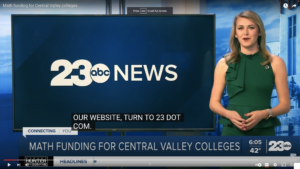 The College Bridge Dual Enrollment Math Bridge Project, in partnership with the Central Valley Higher Education Consortium , was featured by KERO23-ABC in Bakersfield with reporter/anchor Ava Kershner interviewing Dr. Lynn Cevallos, founder and president of College Bridge, and Armin Rashvand, the Taft College dean of instruction.
The College Bridge Dual Enrollment Math Bridge Project, in partnership with the Central Valley Higher Education Consortium , was featured by KERO23-ABC in Bakersfield with reporter/anchor Ava Kershner interviewing Dr. Lynn Cevallos, founder and president of College Bridge, and Armin Rashvand, the Taft College dean of instruction.WHAT THE CV-HEC IS HAPPENING BLOG (March 2023): CCC Chancellor-Select Sonya Christian
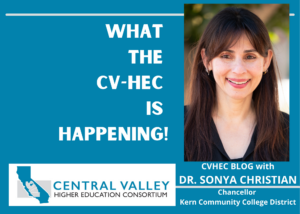 The role of higher education in the Central Valley is increasingly recognized by our state’s elected officials and the public at large. So it carries a particular significance that on Feb. 23, the California Community College Board of Governors appointed Dr. Sonya Christian, chancellor of the Kern Community College District, as the incoming chancellor of the state’s community college system. Dr. Christian is a proven champion of the under-represented populations served by the community colleges in the San Joaquin Valley. For this month’s “What The CV-HEC Is Happening” blog, CVHEC’s Executive Director Benjamin Duran connected with Dr. Christian to capture her thoughts about her work in the Central Valley, and the California Community College system as a whole, before she formally steps into her new role this June.
The role of higher education in the Central Valley is increasingly recognized by our state’s elected officials and the public at large. So it carries a particular significance that on Feb. 23, the California Community College Board of Governors appointed Dr. Sonya Christian, chancellor of the Kern Community College District, as the incoming chancellor of the state’s community college system. Dr. Christian is a proven champion of the under-represented populations served by the community colleges in the San Joaquin Valley. For this month’s “What The CV-HEC Is Happening” blog, CVHEC’s Executive Director Benjamin Duran connected with Dr. Christian to capture her thoughts about her work in the Central Valley, and the California Community College system as a whole, before she formally steps into her new role this June.
Higher Ed in the Central Valley
A look at a tenure of accomplishments by KCCD Chancellor chosen to lead the CCC System – Part 1
 Benjamin Duran: Thank you, Sonya, for taking the time to speak with us here at CVHEC, and congratulations again on your appointment to the state Chancellor’s office. We are elated to have an administrator from the Central Valley representing higher education in such an important office. What are your thoughts on the work being done in the valley, and how that ongoing work will inform your work statewide?
Benjamin Duran: Thank you, Sonya, for taking the time to speak with us here at CVHEC, and congratulations again on your appointment to the state Chancellor’s office. We are elated to have an administrator from the Central Valley representing higher education in such an important office. What are your thoughts on the work being done in the valley, and how that ongoing work will inform your work statewide?
 Sonya Christian: Thank you for inviting me, Ben. My focus will be to continue to advance student success and student access with equity … without distractions. This has been my work as president of Bakersfield College (BC), as chancellor of the Kern Community College District (Kern CCD), and it will continue to be my focus as the statewide chancellor.
Sonya Christian: Thank you for inviting me, Ben. My focus will be to continue to advance student success and student access with equity … without distractions. This has been my work as president of Bakersfield College (BC), as chancellor of the Kern Community College District (Kern CCD), and it will continue to be my focus as the statewide chancellor.
The critical challenges we face in the Central Valley are emblematic of the challenges and opportunities we face in California – e.g. the enrollment decline during the pandemic and the basic needs of our students. The challenges are magnified in the Central Valley’s populations with higher levels of poverty, lower educational attainment levels, larger proportions of first-generation college students… and I believe the work we have been doing and will continue to do in the Central Valley should serve as a model for advancing student success with equity in the rest of the state.
Let me take a moment to brag about the innovation that has happened in the Central Valley, and acknowledge the leadership role that CVHEC has had in this work.
Dual Enrollment and Early College
I see Dual Enrollment and Early College as being essential. High school students need to know that they are on the path to college and can succeed on that path. This is all the more important for our first-gen students.
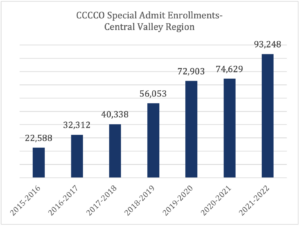 I believe that all our work should be supported by the data. Let me share with you some of the data for the Dual Enrollment/Early College sections in the Central Valley.
I believe that all our work should be supported by the data. Let me share with you some of the data for the Dual Enrollment/Early College sections in the Central Valley.
- Total special admit enrollments increased by 25% in 2021-2022; from 74,629 enrollments in 2020-2021 to 93,248 enrollments 2021-2022 (CA state growth was 5%)
- 21% (93,248 out of 441,691) of all special admit enrollments in California in 2021-2022 were from the Central Valley Region
- 5 out of the 9 high schools that received the CDE’s California Dual Enrollment Exemplary Award were from the Central Valley Region
-
- Arvin High School- Bakersfield College
- Delano High School- Bakersfield College & Cerro Coso Community College
- Robert F. Kennedy High School- Bakersfield College & Cerro Coso Community College
- McFarland High School- Bakersfield College
- Avenal High School- West Hills College, Coalinga
Transfer
The Central Valley has done remarkable work supporting the detailed institutional clarification and creation of transfer pathways, including the implementation of Program Pathways Mapper. E.g., about two years after UC Merced, Merced College and Bakersfield College began collaborating on clarifying transfer pathways as part of a Learning Lab grant, enrolling transfer students took a big jump relative to the overall UC system. In fall 2021 they enrolled 19% more transfers, and in fall 2022 it was 14% more.
In all, UC Merced has published 27 vetted transfer pathways with Merced College and another 29 with Bakersfield College. UC Merced has also been engaging all Central Valley community colleges in linking their program maps to UC Merced to establish a network of transfer pathways for the region.
CSU Bakersfield has also been a leader in transfer pathways mapping with 39 transfer program maps currently linked to Bakersfield College programs.
And CSU Stanislaus has just begun onboarding onto the Program Pathways Mapper, adding more transfer momentum to the region’s guided pathways efforts.
Workforce Development
 The 15 colleges in the Central Valley/Mother Lode (CVML) Regional Consortium have been advancing equity and access for students in many areas:
The 15 colleges in the Central Valley/Mother Lode (CVML) Regional Consortium have been advancing equity and access for students in many areas:
- Increased the number of students who earned a degree, certificate, or apprenticeship by 5%
- Decreased the average number of units accumulated by First-Time Associate Degree Earners by 4%
- Developed over 120 programs in high-priority industry sectors to address skills gaps in the workforce
Here are some examples of great work from our colleges:
- Fresno City College and its sister institutions, Clovis, Madera, and Reedley, are pioneering an apprenticeship program called the California Tribal Environmental and Cultural Equitable Vocational Training to close equity gaps for indigenous residents in two programs: Environmental Science and Protection Technician and Cultural Protection Technician/Monitor. This project is a collaboration with the California Tribal Emergency Response and Relief Agency (CTUAC) and the California Tribal Unilateral Apprenticeship Committee (CTUAC). The purpose of the project is to recruit 25 apprentices from tribal communities.
- Bakersfield College hosted the first CVML Apprenticeship Forum in December 2022 to provide best practice strategies in meeting Governor Newsom’s equity goal of having 500,000 apprenticeships by 2029. Additionally, it received the California Apprenticeship Initiative: New & Innovative grant to develop apprenticeship programs in Information and Communication Technology as well as Perioperative Nursing for underrepresented students.
- West Hills College Lemoore is leading a regional project called Jumpstart for rising seniors to learn about Industrial Automation and gain work experience in an accelerated summer bridge program with Reedley College, College of the Sequoias, and Porterville College.
- Recently, 9 of the CVML colleges (Columbia, Fresno, Bakersfield, Cerro Coso, West Hills College Lemoore, Madera, Merced, San Joaquin Delta, Modesto, College of the Sequoias, Porterville, and Taft) received the second largest award for the Regional Equity and Recovery Partnership (RERP) grant, a partnership among the Labor and Workforce Development Agency (LWDA), the California Workforce Development Board (CWDB), and the California Community College Regional Consortia via the California Community College Chancellor’s Office. These colleges are coordinating a regional effort to improve job quality and access for women and underrepresented populations to help meet economic, social, and environmental needs of the community.
- Bakersfield College, Fresno City College, Merced College, Modesto College, San Joaquin Delta College and West Hills College Coalinga are part of the Rising Scholars Network, a CCCCO DEI initiative, that serves justice-involved and formerly involved students earn certificates and degrees to either transfer or to attain a mid- to high-wage job.
- Fresno City College and Modesto Junior College are two of 14 California community colleges participating in the 3-year College Homeless Housing Insecure Pilot Program to address the 19% of unhoused students.
These selected initiatives make visible the scope of committed work in the Central Valley to support access with equity, and success with equity.

Ben: Whoa, that is a lot of data! I guess that is what you get when you have a conversation with a former math faculty. Now, Early College and Dual Enrollment has a lot of potential in the Central Valley, and Kern CCD has been one of the leaders in that space for several years. How has your work in this area as President of Bakersfield College and Chancellor of Kern CCD prepared you for this new role?
 Sonya: It has been the greatest pleasure of my career to be able to give back to the district where I started in higher education as a math instructor. I came to USC as a foreign graduate student and was first hired as a math faculty at BC. The President at that time, Rick Wright, and the Chancellor Jim Young, sponsored me for my green card. And now I am a citizen of this amazing country.
Sonya: It has been the greatest pleasure of my career to be able to give back to the district where I started in higher education as a math instructor. I came to USC as a foreign graduate student and was first hired as a math faculty at BC. The President at that time, Rick Wright, and the Chancellor Jim Young, sponsored me for my green card. And now I am a citizen of this amazing country.
The 25,000 sq miles of Kern’s Service area includes rural communities with lower economic and educational attainment levels, and includes a range of strong industries like agriculture, energy, defense and aerospace, healthcare and logistics. The work done by the three colleges in the Kern district – Porterville College, Cerro Coso College, and Bakersfield College – has focused on advancing equity in access to a college education, equity in completing a degree or certificate, and equity in placement in good jobs. Various initiatives that were started as innovative projects have been institutionalized and are now a part of how we do our work.

The Early College efforts started with our rural communities of McFarland, Delano, Wasco, Shafter and Arvin/Lamont. Kern has also see
n rapid growth in our health care programs and we are working closely with industry and community-based organizations to move our energy-
related work.
With the Governor’s ambitious climate agenda, I see community colleges as providing the necessary infrastructure and engagement for all of our communities, offering educational attainment with equity, and creating economic mobility with equity. Kern has established a satellite presence of the National Renewable Energy Laboratory called the California Renewable Energy Laboratory (CREL).
And I have to mention the deep work that Kern has done using the Guided Pathways framework, work that has resulted in significant improvements in student success outcomes with equity.
This work was done to meet the needs of students of the colleges of the Kern Community College District (KernCCD)and the Central Valley. But of course the fundamental needs are in common to students at colleges across the state. In that regard meeting the needs of the populations we serve at the Kern CCD and the Central Valley has prepared me well for the work ahead.
 Ben: Throughout your career as an administrator, you’ve demonstrated a forward-thinking, outside-the-box approach. What are some of your other big priorities as you step into your new role as state chancellor this June?
Ben: Throughout your career as an administrator, you’ve demonstrated a forward-thinking, outside-the-box approach. What are some of your other big priorities as you step into your new role as state chancellor this June?

Sonya: At the February 23rd, Board of Governors meeting where I was appointed, I made the following comment:
The Board of Governors is tasking the 11th Chancellor of the California Community Colleges to be both implementer and visionary, all at once, to further advance the next frontier of student success with equity. Our work then is twofold: (1) Implement the Vision for Success with equity, fidelity, at scale, using the identified metrics, and (2) expand the canopy of community college learners , to accelerate the socio-economic mobility for our most marginalized communities through partnerships that will reach working adults, disconnected youth and others left behind.
Let me call out a few specific pieces of work:
One of my first priorities will be to work alongside the Cal State and UC systems to improve intersegmental transfer from the community colleges into four-year institutions. We’ve talked previously about implementing the Vision for Success and the Governor’s Roadmap with equity and at scale, and that includes the community college transfer students moving to a four-year university and completing their bachelor’s degree.
Workforce Development has been on the top of my mind the last few years. Systematically providing opportunities for working adults, disconnected youth and other learners who previously have been bypassed, is the next wave of our Guided Pathways work. Our work today is creating the future of learning where there are many more flexible onramps to educational pathways that lead to quality jobs.
The Governor’s Roadmap calls out four priority sectors – healthcare, climate action, education and early education. Community colleges – together with our partners – must lead the way to meet these goals.
At Kern, I have been working on the Climate Action agenda specifically in the areas of Carbon Capture and Sequestration, Clean Transportation, and Grid Resilience. I believe that Community Colleges are essential in advancing the state and federal goals for decarbonization and climate action, and it will be especially important to support the clean energy transition in the Central Valley.
Last and certainly not least, supporting our students with their basic needs by providing customized support for the diverse students we serve. This includes the work we have started with mental health support, affordable student housing and the Cal Grant Reform.
 Ben: Sonya, I am glad you mentioned transfer. You know that CVHEC has identified this as a priority and has done great work on transfer pathways. How do you see this playing out at the state level?
Ben: Sonya, I am glad you mentioned transfer. You know that CVHEC has identified this as a priority and has done great work on transfer pathways. How do you see this playing out at the state level?
 Sonya: Increasing baccalaureate attainment has always been a priority for me, ever since I started as President of BC. Many of the underserved rural communities in Kern’s service have low educational attainment levels – this is why we launched, with urgency, the Rural Initiative as an equity imperative to advance educational attainment levels with the goal of advancing the socio-economic standing of these communities. In this work, we specifically focused on: (i) increasing baccalaureate completion by creating transfer pathways from high schools through the community college to a four-year university as well as (ii) bringing bachelor’s degrees closer to home by developing local Community College Baccalaureate programs that lead to high-wage jobs.
Sonya: Increasing baccalaureate attainment has always been a priority for me, ever since I started as President of BC. Many of the underserved rural communities in Kern’s service have low educational attainment levels – this is why we launched, with urgency, the Rural Initiative as an equity imperative to advance educational attainment levels with the goal of advancing the socio-economic standing of these communities. In this work, we specifically focused on: (i) increasing baccalaureate completion by creating transfer pathways from high schools through the community college to a four-year university as well as (ii) bringing bachelor’s degrees closer to home by developing local Community College Baccalaureate programs that lead to high-wage jobs.
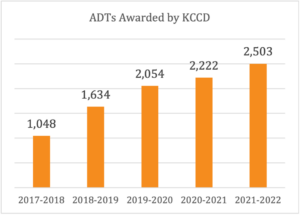
The transfer legislation SB 1440 and the creation of the Associate Degree for Transfer (ADT) helped Kern increase completion rates of the transfer degree. The graph shows the number of ADTs awarded at Kern increased from just over 1,000 five years ago in 2017-2018 to just over 2,500 in 2021-22; that is an increase of 146%.
And for California Community Colleges as a whole, the five-year increase from 36,101 ADTs conferred in 2016-17 to 62,934 in 2020-21 represents a 74% increase.
As more and more students complete the ADT, we need to ensure that the number of applications to our transfer institutions is increasing, as well. This will be a priority for me as I transition to my new role.
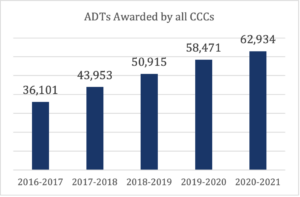 The Community College Baccalaureate is important to me. I remember the excitement that rippled through California’s Community Colleges in 2015 when SB 805 passed that launched the 15-college baccalaureate pilot program. And later in 2021 with AB 927 institutionalizing the pilot. In the Central Valley, Bakersfield College is providing high-wage, workforce-focused baccalaureate degrees and has two baccalaureate degree programs: Industrial Automation and Research Laboratory Technician. Also, Modesto Junior College offers a Respiratory Care B.S. degree, and other Central Valley colleges are developing baccalaureate degree programs. The Community College Baccalaureate will be a priority as I transition to my new role.
The Community College Baccalaureate is important to me. I remember the excitement that rippled through California’s Community Colleges in 2015 when SB 805 passed that launched the 15-college baccalaureate pilot program. And later in 2021 with AB 927 institutionalizing the pilot. In the Central Valley, Bakersfield College is providing high-wage, workforce-focused baccalaureate degrees and has two baccalaureate degree programs: Industrial Automation and Research Laboratory Technician. Also, Modesto Junior College offers a Respiratory Care B.S. degree, and other Central Valley colleges are developing baccalaureate degree programs. The Community College Baccalaureate will be a priority as I transition to my new role.
 Ben: As always, it looks like you have an ambitious agenda, and I’m excited to see how the community colleges evolve to support students with equity under your leadership. The Central Valley stands ready to support you in your new role. Thank you again for speaking with us. I know you’ll continue to make the Central Valley proud!
Ben: As always, it looks like you have an ambitious agenda, and I’m excited to see how the community colleges evolve to support students with equity under your leadership. The Central Valley stands ready to support you in your new role. Thank you again for speaking with us. I know you’ll continue to make the Central Valley proud!
CVHEC DIRECTOR’S MESSAGE (March 2023): Spring forward!
Spring forward to our CVHEC summit, Math Bridge Kick-off and Kern Mentors!
Welcome to this month’s CVHEC e-Newsletter. As we move into the spring of 2023 with a little more daylight on our hands, we are happy to share some timely items following our last issue.
First, as we in the Central Valley continue to bask in the pride and excitement of our own Dr. Sonya Christian, chancellor of the Kern Community College District, being chosen by the California Community Colleges Board of Governors to lead the California Community College System, we are delighted to feature her in this issue’s “What the CV-HEC Is Happening Blog.” 
The Chancellor-select reflects on her time working in the valley with her fellow presidents and chancellors on the CVHEC Board of Directors and the strides we have made as a united voice for higher education in our nine-county region [or Kern Co if that is what the blog focuses on]. Please enjoy her guest blog in this month’s issue and, once again, congratulations Sonya!
Registration for the CVHEC Annual Summit is now open!
Please plan on joining us May 12 for this great event as well as our special CVHEC Welcome Reception the day before at Arte Americas. The summit – always historic in that it brings together the higher education leadership in our nine-county region – provides the opportunity to showcase the great work that is taking place in our Central Valley colleges and universities to provide meaningful pathways for our students seeking a higher education.
In furtherance of our mission to increase access to college for students, we are pleased to announce the Central Valley Math Bridge Kick-off May 18 in downtown Fresno with our partners College Bridge and the Rand Corporation. With this the formal launch, we are excited to shine a light on the great work that can come out of small colleges in the Central Valley that we will share with the rest of the state and eventually nationally as this project creates a model for meaningful dual enrollment math pathways and expansion that can be replicated in other regions of California.
This same spirit carries forth in the South Valley where our Kern Master’s Upskilling Project is now recruiting community college professors to serve as mentors for high school teachers enrolled in the project to earn master’s degrees in math or English. In collaboration with the Kern Regional K-16 Education Collaborative, we are working to improve student progress from high school to postsecondary education and ultimately into the workforce by providing 100 South Valley high school teachers the opportunity to earn a master’s degree that achieves state qualifications for teaching community college dual enrollment English or math courses at local high schools.
We encourage Kern area community college math and English professors to join us in this innovative project.
And finally, as we close out March next week, let us acknowledge Women’s History Month by expressing our appreciation to the incredible women leaders who serve on the CVHEC Board of Directors as the presidents or chancellors of the colleges and universities in our region, led by board chairwoman Dr. Kristin Clark, chancellor the West Hills Community College District.
As you read through this issue, we hope you find inspiration in the many great higher education advancements taking place in the Central Valley. Thanks for being a partner and a friend of CVHEC.


